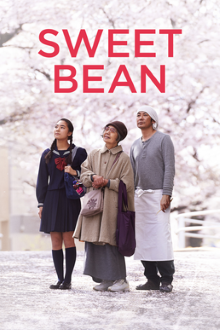
This is yet another quintessentially Japanese film that was a recommendation from our cinephile friend. Given its title and its premise, I expected it to be light fare. Indeed, though it touches on some heavy themes, it’s ultimately a very sentimental film if a very well-made one.
Sentaro is a middle-aged man who runs a small dorayaki shop frequented by schoolgirls. One of these is Wakana, a girl who is being seemingly neglected by her mother. One day an old woman, Tokue, comes to the shop and seeing Sentaro’s notice, applies for a job. Seeing her advanced age and crippled hands, Sentaro refuses. The next day she returns, bringing with her a box of homemade bean paste. Sentaro is forced to acknowledge that it is better than anything he has ever tasted and hires her to teach him how to make it. It takes much more work than he expected but the new paste turns out to be a huge hit and brings many customers. Perhaps more importantly Sentaro who is dealing with personal demons of his own, notices how Tokue is always full of joy and appreciates everything around her. Sentaro, Wakano and Tokue all become friends with one another. Unfortunately the owner of the shop points out that Tokue’s deformed hands is likely the result of leprosy and pressures Sentaro to fire her.
Revealing that last bit is a spoiler but I wouldn’t have much to write about otherwise. Knowing nothing about that turn of events beforehand, I was very surprised by it and felt that it added some weight and depth to what would otherwise be too light a film. The themes of valuing simple freedoms, the myriad possibilities of life and the beauty of nature are all very familiar ones from Japanese culture and might feel a bit too generic but what sells it here is the performance of Kirin Kiki as Tokue. She is so perfect for the role that I convinced for a while that she must really be someone who has suffered from leprosy but it turns out that she is a very well known veteran actress in Japan. The cinematography is as pretty and pleasant as you can expect even if they do hammer on the sakura visuals rather heavily.
I did find that the ending drags on too long and dips too deep into the kind of mystical sentimentality that is meant to feel profound but always ends up annoying my inner skeptic. I was also surprised that the film didn’t take the opportunity to include some exposition on the disease and expand its scope a bit to talk about how patients were treated in the past. Overall, it’s a pleasant, beautiful film with strong acting and that makes it worth watching. I suppose it’s also a great example of the very Japanese concept of harmony. But its inoffensiveness and agreeableness also means that it likely won’t be a very memorable work.